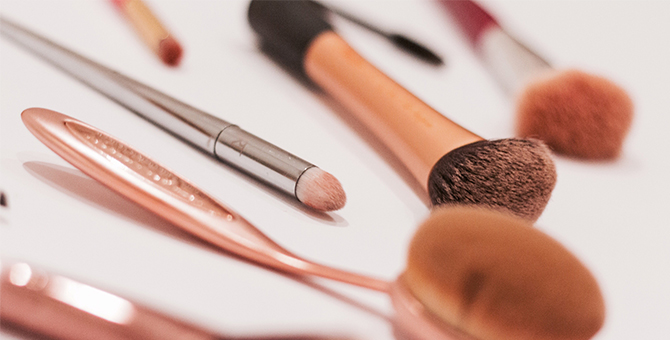If you already know the nasty things dirty makeup brushes can do to your skin (cringe), here’s what you need to know next: working on reversing the icky effects—stat. And we’ve asked professional makeup artist, Cat Yong to weigh in on the best solutions and expert tips to get the job done. Healthy, glowing skin; ready or not, here we come.
Give us a quick guide to makeup brush cleansing.
“The trick is to care for it as you would your hair. Gently cleanse brushes with a light cleansing shampoo, gentle soap or conditioner. Of course, a brush cleansing product works perfectly too.
“Thoroughly wash the brush heads but do not scrub them. Work up a lather using a gentle back and forth motion, allowing it to absorb the cleanser and work through the bristles.
“Then, gently run it under water (still using that back and forth motion with the brush head facing downwards) until the water runs clean. Lastly, lay the brush flat to dry.”
Try: M.A.C Cosmetics Brush Cleaner
On to the big question—how frequently do we need to wash our makeup brushes?
“For makeup artists, we generally wash them daily after each job completion to ensure hygiene levels are maintained. For personal use at home, you should get into a routine of washing it after one or two usages so as not to give bacteria a chance to build up and keep your skin at its best.”
Try: Beautyblender Original + Solid Cleanser Kit
What are some of the things to avoid when it comes to caring for our brushes?
“Do not stand the brushes upright on their bristles as this will affect the shape of the brushes over time.
“Brushes should be (as much as possible) shaped back into their original state before laying flat after each wash to maintain its natural shape. When laying brushes out, avoid stacking brushes on top of one another, as this will cause the bristles to lose its shape and dry in that form. This will in turn, affect the way it does its job when applying makeup.”
Try: Sigma Beauty Sigma Spa Brush Cleaning Mat
Top tips to reducing the chances of bacteria buildup in our makeup kits?
“This may be challenging for most of us, but ideally, we should clean our brushes, sponges and power puffs after each use, every day.
“Try not use them directly on the products. Pick up product separately with a spatula or small teaspoon so you’re not transferring anything from the brushes and sponges onto the product. Snap all items shut immediately after to avoid the product from drying out or worse, trapping dirt and oil from its surroundings – this is especially true for products with a creamy or liquid texture such as mascaras, gel and liquid liners, lipsticks, glosses and liquid foundation.
“And of course, most importantly, avoid from sharing products with other people as you may not be aware of how their makeup and tools are being cared for, expiry dates and so on – you’ll be doing your skin the biggest favour!”
Try: Make Up For Ever Instant Brush Cleanser
Finally, how can we tell when a brush has run its course?
“After a period of time, brushes may lose its strength and start shedding hair. Also, bristles with the tendency to stick out over time, causing discomfort (and in some cases, irritation) to the skin is a good indication that it’s time for it to be replaced.”
| SHARE THE STORY | |
| Explore More |




